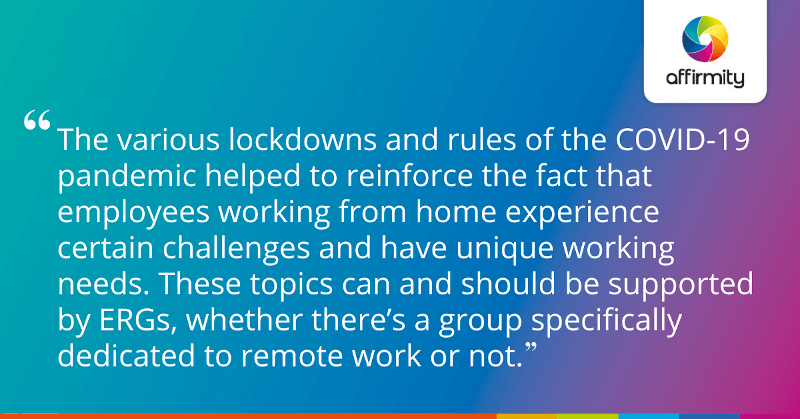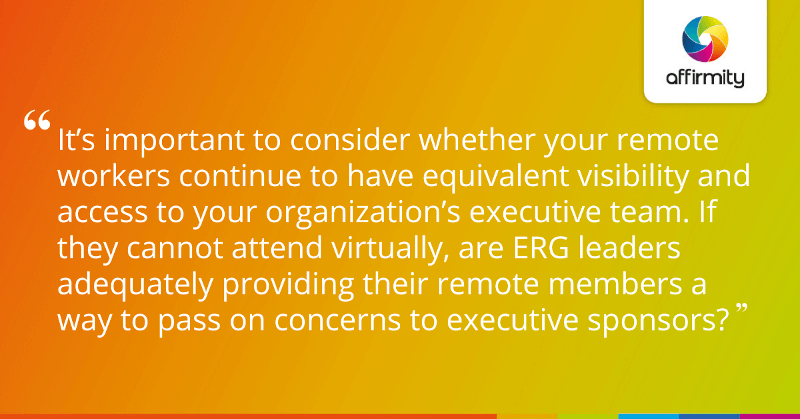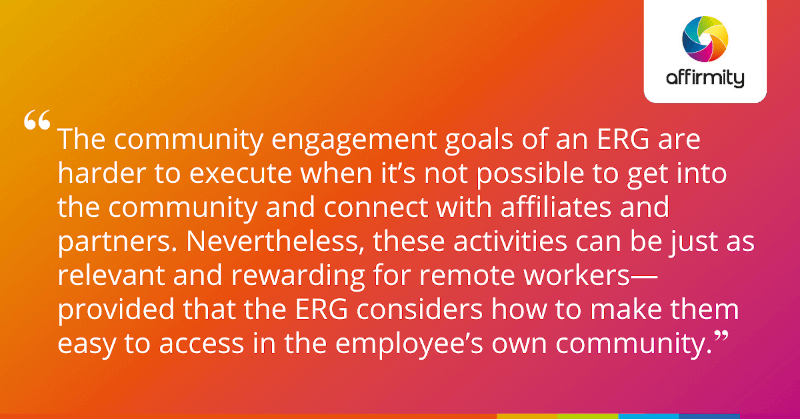COVID-19-related lockdowns made the world aware of both the positive and negative realities of remote work. With many employers and employees likely to relax compulsory office working in the years ahead, what can Employee Resource Groups (ERGs) learn from lockdown in order to make the working lives of remote workers even better?
In our webinar ‘Using ERGs to Drive Engagement in a Virtual Work Environment’, D&I representatives at Northrop Grumman, Danaher, and Health Care Service Corporation (HCSC) shared their ERG experiences during the 2020 lockdown. In this article, we discuss what those experiences can tell us about the future of remote work.
1) Why You Should Consider Forming Virtual Worker ERGs and Chapters
The various lockdowns and rules of the COVID-19 pandemic helped to reinforce the fact that employees working from home experience certain challenges and have unique working needs. These topics can and should be supported by ERGs, whether there’s a group specifically dedicated to remote work or not.
Northrop Grumman’s D&I team had been in the process of developing vERGe—an ERG to advocate for the needs of their virtual workers and the role they play within the company—for around a year before launching in March 2020, the same month that the global pandemic was declared.
In this context, vERGe immediately became an asset for a larger group of employees than anticipated. A kick-off webinar discussing home office setup with an external ergonomics specialist attracted around six times the number of participants originally projected. Members of the ERG also became a valuable internal pool of expertise, assisting members of other ERGs with work-from-home issues and best practices at a time of increased IT helpdesk activity.
 Organizations could go one step further than this and establish virtual chapters for all of their ERGs. This acknowledges that virtual workers are as important as your geographical chapters, and is particularly helpful when there are special interest issues that intersect with virtual work. For example, a virtual worker chapter within a Families ERG may have childcare issues that differ slightly from chapters for your major offices.
Organizations could go one step further than this and establish virtual chapters for all of their ERGs. This acknowledges that virtual workers are as important as your geographical chapters, and is particularly helpful when there are special interest issues that intersect with virtual work. For example, a virtual worker chapter within a Families ERG may have childcare issues that differ slightly from chapters for your major offices.
For more on innovating with Employee Resource Groups, read: ‘5 Key Steps in the Creation, Growth and Evolution of Your ERGs’
2) How to Make Programming Accessible by, and Targeted at Remote Workers
In many organizations, ERG leaders plan a full calendar year of events at once, often based around certain commemorative events. When workforces were suddenly all working from home in 2020, many ERG leaders had to reexamine whether these events were still viable virtually. ERGs that already accounted for remote worker participation naturally found this transition easier—and every group would benefit from examining whether a decent portion of their usual programming is accessible to remote workers.
Whether an activity is accessible by remote workers is one consideration; whether it’s relevant or useful is another. Organizations didn’t necessarily experience falls in participation during the pandemic, but certain types of events were more successful than others.
For example, ERGs found they could help virtual workers acclimate to work from home with morning or lunchtime coffee sessions (or after-work happy hours) with no formal agenda and space and time to talk. Programming around mental and physical health also proved popular, especially when outside professionals were brought in to lead sessions. Other tried and tested ideas included:
- Virtual fundraising walks
- Food donation drives
- Salsa lessons
- Cultural trivia games
- Cooking demonstrations
Format is another consideration—a ‘bring your child to work day’ may work better when spread out over a week or opened up to other family members (the novelty of bringing a child to work being somewhat undermined when your child is always in your workplace). Self-service information portals can also be useful, whether that’s a D&I team creating a central COVID-19, work from home, or social justice resource, or ERGs taking this task on themselves.
Hand-picked for you: ‘Maximizing the Value of ERGs: Expert Answers to 7 Burning Questions’
3) The Importance of Maintaining C-Suite Participation
We’ve talked previously about the importance of the top of the business leading by example on the kind of culture it wants to create. Many organizations achieve this via strategic priorities, action plans, and performance goals for their executive team.
C-Suite members will typically function as executive sponsors for the ERGs and are encouraged to attend group events and learn from employee voices in that context. This insight feeds back into the D&I targets they’re accountable to.
 ERGs that thrived during 2020 generally continued to have access to leadership figures as guest speakers and in their mentorship programs. Remote working and social injustice were inevitable topics during the year. This provided a chance for senior leaders to express their thoughts about what’s going on, and to share and listen to personal stories in the business.
ERGs that thrived during 2020 generally continued to have access to leadership figures as guest speakers and in their mentorship programs. Remote working and social injustice were inevitable topics during the year. This provided a chance for senior leaders to express their thoughts about what’s going on, and to share and listen to personal stories in the business.
Going forward, it’s important to consider whether your remote workers continue to have equivalent visibility and access to your organization’s executive team. If they cannot attend virtually, are ERG leaders adequately providing their remote members a way to pass on concerns to executive sponsors? Are remote workers benefiting from the opportunity to see a different side to senior bosses?
4) The Great Value of Encouraging Joint ERG Initiatives
Collaboration between ERGs thrived in 2020. This was in part due to the social injustice conversations that flared during the middle of the year, as groups formed a united front, discussed what they could do as allies of affected groups, and made shows of solidarity.
Meanwhile, as ERGs reconsidered how to best serve newly remote workforces, it often made sense to pool resources. Sessions on how to effectively work remotely could obviously serve a wider audience, but the affordability of external speakers could be shared between relevant groups. This kind of collaboration grows reach, participation, and memberships. As a section of these workforces return to their offices, it’s important to consider how joint initiatives—via shared expertise and budgets—can continue to keep remote ERG members involved with in-person events.
More on taking a united front on social injustice from the blog: ‘Social Injustice and How Companies Can Support Their Black Employees’
5) How ERGs Can Thrive Despite Falling Participation
Many organizations set ERG KPIs focused on metrics such as attendance that are more difficult to sustain with a fully virtual workforce. Businesses such as the Danaher Corporation relaxed these requirements, recognizing that forcing attendance was counter-supportive—the company decided to support those who could attend, and give those who had other commitments space.
 Even while rethinking what engagement looks like, it’s still possible to work towards increasing employee engagement. HCSC’s L&D team supported its ERGs in holding virtual membership drives, and had each group host an interactive webinar promoted through internal channels and open to all employees. These drives helped re-introduce the idea of ERGs to employees who were less aware of what they were. In particular, it was felt that newer employees had fallen through the cracks in the onboarding rush.
Even while rethinking what engagement looks like, it’s still possible to work towards increasing employee engagement. HCSC’s L&D team supported its ERGs in holding virtual membership drives, and had each group host an interactive webinar promoted through internal channels and open to all employees. These drives helped re-introduce the idea of ERGs to employees who were less aware of what they were. In particular, it was felt that newer employees had fallen through the cracks in the onboarding rush.
Certain activities inevitably fell off in lockdown. The volunteerism and community engagement goals of an ERG are harder to execute on when it’s not possible to get into the community and connect with affiliates and partners. In normal circumstances, these activities can be just as relevant and rewarding for remote workers—provided that the ERG considers how to make them easy to access in the employee’s own community.
